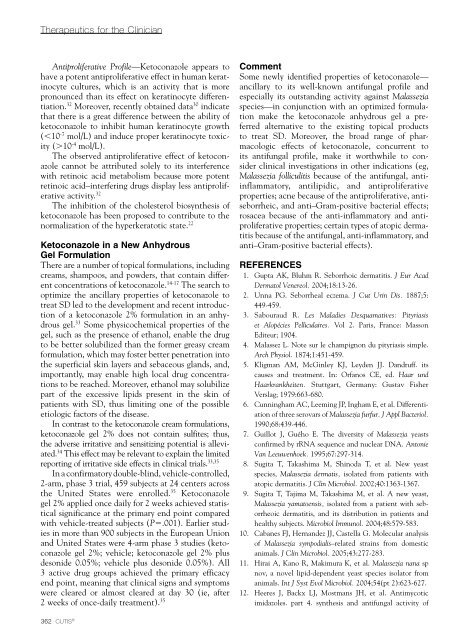The Role of Ketoconazole in Seborrheic Dermatitis
The Role of Ketoconazole in Seborrheic Dermatitis
The Role of Ketoconazole in Seborrheic Dermatitis
Create successful ePaper yourself
Turn your PDF publications into a flip-book with our unique Google optimized e-Paper software.
<strong>The</strong>rapeutics for the Cl<strong>in</strong>ician<br />
Antiproliferative Pr<strong>of</strong>ile—<strong>Ketoconazole</strong> appears to<br />
have a potent antiproliferative effect <strong>in</strong> human kerat-<br />
<strong>in</strong>ocyte cultures, which is an activity that is more<br />
pronounced than its effect on kerat<strong>in</strong>ocyte differentiation.<br />
32 Moreover, recently obta<strong>in</strong>ed data 30 <strong>in</strong>dicate<br />
that there is a great difference between the ability <strong>of</strong><br />
ketoconazole to <strong>in</strong>hibit human kerat<strong>in</strong>ocyte growth<br />
(,10 -7 mol/L) and <strong>in</strong>duce proper kerat<strong>in</strong>ocyte toxicity<br />
(.10 -4 mol/L).<br />
<strong>The</strong> observed antiproliferative effect <strong>of</strong> ketoconazole<br />
cannot be attributed solely to its <strong>in</strong>terference<br />
with ret<strong>in</strong>oic acid metabolism because more potent<br />
ret<strong>in</strong>oic acid–<strong>in</strong>terfer<strong>in</strong>g drugs display less antiproliferative<br />
activity. 32<br />
<strong>The</strong> <strong>in</strong>hibition <strong>of</strong> the cholesterol biosynthesis <strong>of</strong><br />
ketoconazole has been proposed to contribute to the<br />
normalization <strong>of</strong> the hyperkeratotic state. 22<br />
<strong>Ketoconazole</strong> <strong>in</strong> a New Anhydrous<br />
Gel Formulation<br />
<strong>The</strong>re are a number <strong>of</strong> topical formulations, <strong>in</strong>clud<strong>in</strong>g<br />
creams, shampoos, and powders, that conta<strong>in</strong> different<br />
concentrations <strong>of</strong> ketoconazole. 14-17 <strong>The</strong> search to<br />
optimize the ancillary properties <strong>of</strong> ketoconazole to<br />
treat SD led to the development and recent <strong>in</strong>troduction<br />
<strong>of</strong> a ketoconazole 2% formulation <strong>in</strong> an anhydrous<br />
gel. 33 Some physicochemical properties <strong>of</strong> the<br />
gel, such as the presence <strong>of</strong> ethanol, enable the drug<br />
to be better solubilized than the former greasy cream<br />
formulation, which may foster better penetration <strong>in</strong>to<br />
the superficial sk<strong>in</strong> layers and sebaceous glands, and,<br />
importantly, may enable high local drug concentrations<br />
to be reached. Moreover, ethanol may solubilize<br />
part <strong>of</strong> the excessive lipids present <strong>in</strong> the sk<strong>in</strong> <strong>of</strong><br />
patients with SD, thus limit<strong>in</strong>g one <strong>of</strong> the possible<br />
etiologic factors <strong>of</strong> the disease.<br />
In contrast to the ketoconazole cream formulations,<br />
ketoconazole gel 2% does not conta<strong>in</strong> sulfites; thus,<br />
the adverse irritative and sensitiz<strong>in</strong>g potential is alleviated.<br />
34 This effect may be relevant to expla<strong>in</strong> the limited<br />
report<strong>in</strong>g <strong>of</strong> irritative side effects <strong>in</strong> cl<strong>in</strong>ical trials. 33,35<br />
In a confirmatory double-bl<strong>in</strong>d, vehicle-controlled,<br />
2-arm, phase 3 trial, 459 subjects at 24 centers across<br />
the United States were enrolled. 35 <strong>Ketoconazole</strong><br />
gel 2% applied once daily for 2 weeks achieved statistical<br />
significance at the primary end po<strong>in</strong>t compared<br />
with vehicle-treated subjects (P5.001). Earlier studies<br />
<strong>in</strong> more than 900 subjects <strong>in</strong> the European Union<br />
and United States were 4-arm phase 3 studies (ketoconazole<br />
gel 2%; vehicle; ketoconazole gel 2% plus<br />
desonide 0.05%; vehicle plus desonide 0.05%). All<br />
3 active drug groups achieved the primary efficacy<br />
end po<strong>in</strong>t, mean<strong>in</strong>g that cl<strong>in</strong>ical signs and symptoms<br />
were cleared or almost cleared at day 30 (ie, after<br />
2 weeks <strong>of</strong> once-daily treatment). 35<br />
362 CUTIS ®<br />
Comment<br />
Some newly identified properties <strong>of</strong> ketoconazole—<br />
ancillary to its well-known antifungal pr<strong>of</strong>ile and<br />
especially its outstand<strong>in</strong>g activity aga<strong>in</strong>st Malassezia<br />
species—<strong>in</strong> conjunction with an optimized formulation<br />
make the ketoconazole anhydrous gel a preferred<br />
alternative to the exist<strong>in</strong>g topical products<br />
to treat SD. Moreover, the broad range <strong>of</strong> pharmacologic<br />
effects <strong>of</strong> ketoconazole, concurrent to<br />
its antifungal pr<strong>of</strong>ile, make it worthwhile to consider<br />
cl<strong>in</strong>ical <strong>in</strong>vestigations <strong>in</strong> other <strong>in</strong>dications (eg,<br />
Malassezia folliculitis because <strong>of</strong> the antifungal, anti-<br />
<strong>in</strong>flammatory, antilipidic, and antiproliferative<br />
properties; acne because <strong>of</strong> the antiproliferative, antiseborrheic,<br />
and anti–Gram-positive bacterial effects;<br />
rosacea because <strong>of</strong> the anti-<strong>in</strong>flammatory and anti-<br />
proliferative properties; certa<strong>in</strong> types <strong>of</strong> atopic dermatitis<br />
because <strong>of</strong> the antifungal, anti-<strong>in</strong>flammatory, and<br />
anti–Gram-positive bacterial effects).<br />
ReFeReNCeS<br />
1. Gupta AK, Bluhm R. Seborrhoic dermatitis. J Eur Acad<br />
Dermatol Venereol. 2004;18:13-26.<br />
2. Unna PG. Seborrheal eczema. J Cut Ur<strong>in</strong> Dis. 1887;5:<br />
449-459.<br />
3. Sabouraud R. Les Maladies Desquamatives: Pityriasis<br />
et Alopécies Pelliculaires. Vol 2. Paris, France: Masson<br />
Editeur; 1904.<br />
4. Malassez L. Note sur le champignon du pityriasis simple.<br />
Arch Physiol. 1874;1:451-459.<br />
5. Kligman AM, McG<strong>in</strong>ley KJ, Leyden JJ. Dandruff. its<br />
causes and treatment. In: Orfanos CE, ed. Haar und<br />
Haarkrankheiten. Stuttgart, Germany: Gustav Fisher<br />
Verslag; 1979:663-680.<br />
6. Cunn<strong>in</strong>gham AC, Leem<strong>in</strong>g JP, Ingham E, et al. Differentiation<br />
<strong>of</strong> three serovars <strong>of</strong> Malassezia furfur. J Appl Bacteriol.<br />
1990;68:439-446.<br />
7. Guillot J, Guého E. <strong>The</strong> diversity <strong>of</strong> Malassezia yeasts<br />
confirmed by rRNA sequence and nuclear DNA. Antonie<br />
Van Leeuwenhoek. 1995;67:297-314.<br />
8. Sugita T, Takashima M, Sh<strong>in</strong>oda T, et al. New yeast<br />
species, Malassezia dermatis, isolated from patients with<br />
atopic dermatitis. J Cl<strong>in</strong> Microbiol. 2002;40:1363-1367.<br />
9. Sugita T, Tajima M, Takashima M, et al. A new yeast,<br />
Malassezia yamatoensis, isolated from a patient with seborrheoic<br />
dermatitis, and its distribution <strong>in</strong> patients and<br />
healthy subjects. Microbiol Immunol. 2004;48:579-583.<br />
10. Cabanes FJ, Hernandez JJ, Castella G. Molecular analysis<br />
<strong>of</strong> Malassezia sympodialis–related stra<strong>in</strong>s from domestic<br />
animals. J Cl<strong>in</strong> Microbiol. 2005;43:277-283.<br />
11. Hirai A, Kano R, Makimura K, et al. Malassezia nana sp<br />
nov, a novel lipid-dependent yeast species isolator from<br />
animals. Int J Syst Evol Microbiol. 2004;54(pt 2):623-627.<br />
12. Heeres J, Backx LJ, Mostmans JH, et al. Antimycotic<br />
imidazoles. part 4. synthesis and antifungal activity <strong>of</strong>


